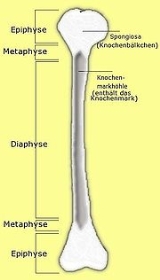
Metaphysis
Encyclopedia

Long bone
The long bones are those that are longer than they are wide. They are one of five types of bones: long, short, flat, irregular and sesamoid. Long bones, especially the femur and tibia, are subjected to most of the load during daily activities and they are crucial for skeletal mobility. They grow...
adjacent to the epiphyseal plate
Epiphyseal plate
The epiphyseal plate is a hyaline cartilage plate in the metaphysis at each end of a long bone...
. It is this part of the bone that grows during childhood; as it grows, it ossifies near the diaphysis and the epiphyses. At roughly 18 to 25 years of age, the metaphysis stops growing altogether and completely ossifies into solid bone.
Epiphyseal plates ("growth plates") are located in the metaphysis and are responsible for growth in the length of the bone.
Clinical significance
Because of their rich blood supply, metaphysis of long bones are prone to hematogenous spread of osteomyelitisOsteomyelitis
Osteomyelitis simply means an infection of the bone or bone marrow...
in children.
Metaphyseal tumors or lesions include osteosarcoma
Osteosarcoma
Osteosarcoma is an aggressive cancerous neoplasm arising from primitive transformed cells of mesenchymal origin that exhibit osteoblastic differentiation and produce malignant osteoid...
, chondrosarcoma
Chondrosarcoma
Chondrosarcoma is a cancer composed of cells derived from transformed cells that produce cartilage. Chondrosarcoma is a member of a category of "soft tissue" malignancies known as sarcomas. About 30% of skeletal system cancers are chondrosarcomas...
, fibrosarcoma
Fibrosarcoma
Fibrosarcoma is a malignant tumor derived from fibrous connective tissue and characterized by immature proliferating fibroblasts or undifferentiated anaplastic spindle cells.Usually in males ages 30 to 40. Originates in fibrous tissues of the bone. Invades long or flat bones such as femur, tibia,...
, osteoblastoma
Osteoblastoma
Osteoblastoma is an uncommon osteoid tissue-forming primary neoplasm of the bone.It has clinical and histologic manifestations similar to those of osteoid osteoma; therefore, some consider the two tumors to be variants of the same disease, with osteoblastoma representing a giant osteoid osteoma...
, enchondroma
Enchondroma
An Enchondroma is a cartilage cyst found in the bone marrow. Typically, enchondroma is discovered on a X-ray scan. Enchondromas have a characteristic appearance on Magnetic Resonance Imaging as well. They have also been reported to cause increased uptake on PET...
, fibrous dysplasia
Fibrous dysplasia
Fibrous dysplasia is a disease that causes bone thinning and growths or lesions in one or more bones, and leads to bone weakness and scar formation within the bones.-Presentation:...
, simple bone cyst, aneurysmal bone cyst
Aneurysmal bone cyst
Aneurysmal bone cyst is a benign osteolytic bone neoplasm characterized by blood filled spaces separated by fibrous septa. The term aneurysmal is mainly derived from its macroscopic appearance.- Causes :...
, non-ossifying fibroma, and osteoid osteoma
Osteoid osteoma
An osteoid osteoma is a benign bone tumor which arises from osteoblasts and originally thought to be a smaller version of an osteoblastoma. Osteoid osteomas tend to be less than 1.5 cm in size. The tumor can be in any bone in the body but are most common in long bones, such as the femur and tibia....
.

